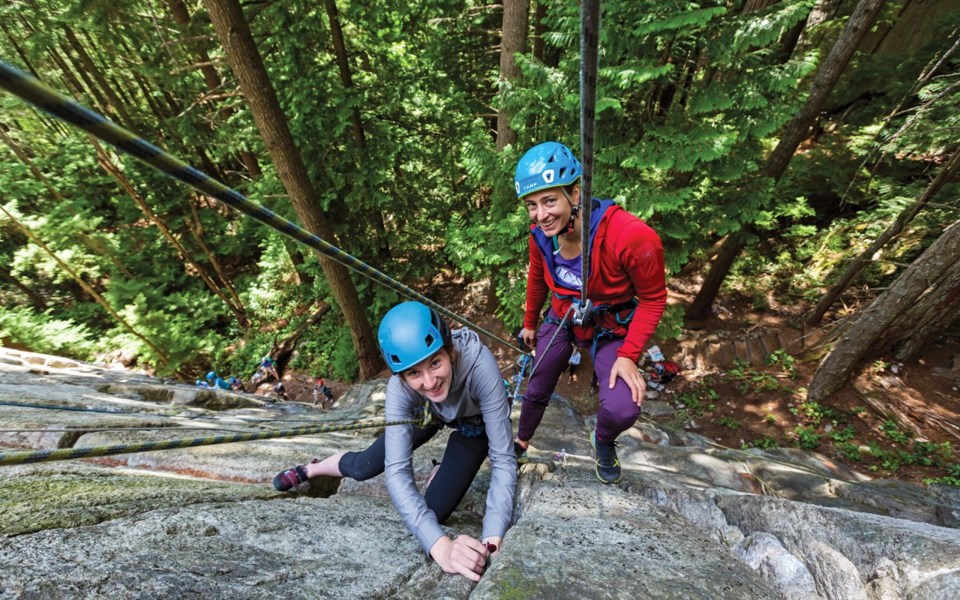Advanced Women's Climbing," an all-day clinic offered at the Arc'teryx Climbing Academy in Squamish July 21-22, seems innocuous enough when I sign up. I have taught enough women's only ski clinics to know that an all-yin environment can instigate some great breakthroughs. What I hadn't anticipated was that our guides, Arc'teryx endurance athlete and mountaineer Janelle Smiley, and Squamish-based mountain guide Julia Niles, would use "falling therapy" to catalyze those a-ha moments for our crew.
"Falling therapy" is what it sounds like: falling, until you have an emotional breakdown.
Had that been on the brochure, I would have signed up for a different class that day.
Who falls off a cliff on purpose?
In rock climbing, the singular thing you're trying not to do, is fall. Some people might dress that up and say you're trying to find the path of least resistance up a route, or you're participating in a moving meditation but really, you're trying not to fall. And this is wise. This is good. This is a deeply ingrained primal instinct. Evolutionary biology has selected in favour of those who have this genetically endowed reverence for cliff edges and heights, who try not to fall over them. This trait has been selected over and over again. It will not easily be suppressed.
And so this is how the day begins. A small sharing circle—who you are, where you're at, what you're hoping to get out this session—with an astute guide who summarizes our rambling introductions into single penetrating sentences. Then we harness up and climb up a crag of 100 million year old Squamish granodiorite, with the express intention of falling off. Of course, we're on top rope. It's all perceived risk. We will fall onto our safety rope, onto a professionally set up anchor, into clean air, with the assistance and supervision of two professional qualified guides, who have crafted a safe space for us to have this experience. There is no actual risk.
And even so, we resist.
It's a four-step process, says Smiley, matter of factly. Step one: take a breath. Then, relax your arms wide, (so you're not clutching for the rope or a piece of gear, and potentially injuring yourself). Soften the knees, so when you bounce into the wall, you can land softly. And then, look down at the ground (instead of at the wall which creates a terrifying sensation of speed.)
"Got it?" she asks, with a sweet-and-steely smile.
Could there be anything more counterintuitive? Fall and look at the ground? We all know the key to managing is heights is just to not look down, right?
Smiley makes her case. When you know it's OK to take a fall, when your body has some muscle memory of moving through the experience of a sudden fall into space, with grace, you can relax into yourself on a climb, you can grip less, you don't have to exhaust yourself clinging to things that don't need to be so frantically clung to, you can flow lightly up a rock, and when you get to a tricky spot, you can make a calm and calculated decision—where is my protection, will it hold, how far will I fall, is it a clean fall, should I go for it (or back up the piece, plug something in, downclimb, or take a rest)?
It's a very rational and sensible strategy when Smiley lays it out for us.
But first, we have to teach our bodies that it is OK.
Our minds might agree. But our bodies. Do. Not.
I watch my classmates try it out first. There are six of us. And nobody wants to let go. I watch them cling to the rock. I can feel their reluctance. Literally. In the pit of my belly, in the tightening in my chest, in my held breath, in my sweating palms. Most make no sound on the first fall. Then Smiley says, "again." And she makes them climb further, with more slack in the rope, so the fall will be bigger. Eventually, the falling forces a squeak out of everyone. Two women are lowered to the ground crying. One is crying just watching.
What Niles and Smiley know, with their passions for psychology as large as their skills in the mountains, is that most of what holds us back in climbing has nothing to do with climbing. It's the same stuff holding us back in a ton of other areas of our lives. Climbing is just one experiential way to approach that, to rewire our brain patterns, to learn the art of breathing through discomfort.
"Fear is just excitement without breath," says Smiley, and I think about all the times I've held my breath, clenched every muscle in my body, and launched into something—a terrifying cruxy move—with an immediate hot wave of adrenaline and cortisol washing through me. For the record? Those times never worked out.
But the times I remembered to breathe, and managed to override my lizard brain with its shockingly limited repertoire (fight, flight or freeze), to maintain some executive function, and make calculated choices, in the face of discomfort I stayed loose enough to make the moves, and instead of fear, I felt a rush.
It takes immense courage to walk into the fear. There are so many ways we can fall into open space—by asking a guy on a date, striking up a conversation with a stranger, steering a conversation with your parents around to a verboten topic, admitting a vulnerability out loud—but exhilaration lies on the other side of releasing the safety we cling to. It's just a breath away.
The Velocity Project: how to slow the f*&k down and still achieve optimum productivity and life happiness.




